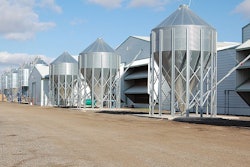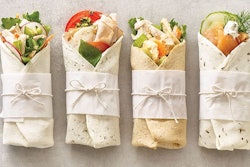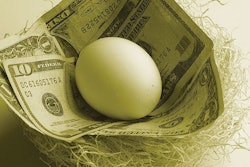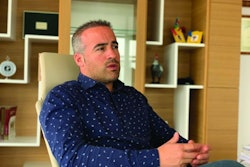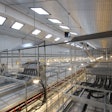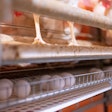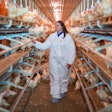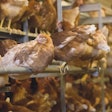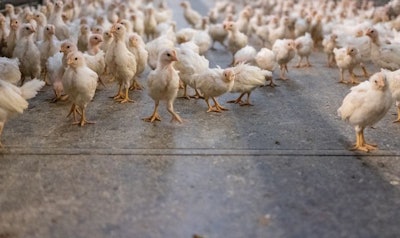
As the number of U.S. hens in cage-free houses increases, egg producers face a learning curve to achieve maximum performance. There is no magic formula that promises to answer all the questions on cage-free production, but rather several factors that each play their own role.
“Success will come from a combination of the right equipment, the correct bird for that equipment, people who are curious and skilled at managing chicken behavior, the right number of people working the house, proper ventilation, as well as good management and vaccination programs,” said Derrick Ament, director of sales for the egg industry at VAL-CO.
Challenges associated with cage-free
When pullets and layers are housed in cages, Ament estimates workers spend 80-90% of their time focused on environmental conditions in the house and keeping equipment functioning properly, leaving 10-20% of their time for bird management.
In aviary systems, the same amount of time must be invested in managing the house and equipment, plus 75% more time working birds during the training period. Producers must plan for higher labor requirements to achieve desired outcomes, he said.
To achieve success in a cage-free system, producers have quickly learned that pullets must be raised in an environment that allows them to move between levels, build muscles and develop behaviors required for the lay house. Lighting challenges including coverage, density, color and dimming capabilities are all being addressed; uniform ventilation requires new approaches, and floor and system eggs laid outside the nests need to be reduced with management and equipment designs.
With that in mind, equipment suppliers continue to refine their products to meet the needs of the U.S. market which are not the same as the European market that has more experience with the use of aviary systems.
Many manufacturers offer egg producers several design options in pullet growing and lay house equipment. Certain manufacturers believe bird variety may point a producer to specific system designs. Some layer varieties prefer to be closer to each other, while others are more independent, curious and move more freely throughout the system. Use of the nesting area also varies by variety, so matching the bird and equipment is extremely important.
Grow-out equipment critical to success in lay house
Pullet systems are being designed with a variety of perches, platforms, ramps and even movable platform levels to encourage strong muscle development. These features are also important to stimulate exploratory behaviors that will help birds better transition to the lay house.
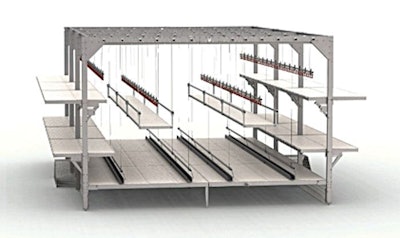
Some manufacturers utilize a winchable platform that can be raised, along with water lines, periodically to appropriate heights as birds grow. (Courtesy Jansen Equipment Co.)
Valli, offered by VAL-CO in the U.S., uses round perches which are designed to build strength and are positioned to force birds to turn around to drink, which the company believes is an important skill in an aviary lay system.
Valli and Salmet have designed pullet growing systems that can be used to grow pullets for either aviary or cage systems.
The Baby Area system from Valli has cascading doors which can be used to keep birds confined during grow-out for traditional lay systems. For aviary lay, pullets can be kept in the system up to 11 weeks before allowing aisle access, depending on the standard and floor space required for the flock. The front part of the module is strong enough for workers to stand or sit on to vaccinate birds and easily perform required husbandry.
Salmet’s new Pedigrow hybrid pullet system can be used by customers who do not know yet whether their market will fully convert to cage-free production. A top tier can be kept closed for use as a conventional system or the entire system can be opened to grow cage-free pullets.
A recent introduction to the U.S. market by Vencomatic is the Bolegg Starter system, which is a hybrid of two older products. This system uses a tree design which starts birds on the lower level. As pullets age, movable platforms and water lines are raised to encourage movement up into the system. A second level with feed availability and an aerated manure belt underneath offers more space for birds as well as a departure point to perches.
Cage-free laying equipment

Egg expeller shown in the highest position, built to manipulate the nesting area. (Courtesy Valli)
Vencomatic and Valli equip their nesting boxes with movable floors. Vencomatic uses a tipping floor, which helps keep the nesting area clean as manure and feathers fall off when raised.
Valli uses a motor-driven egg expeller built to manipulate the nesting area of two of its aviary systems. A rocking motion of the floor encourages birds to move out of the nest when not laying eggs. The back of the nesting area is easily removed to allow workers maintenance access to the egg belt and to easily replace nest pads.
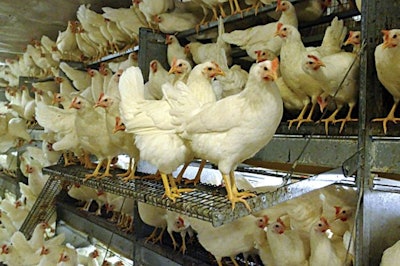
Improved approach ramps, platforms and perches in Salmet pullet and layer systems allow for easier access for birds moving between levels. (Courtesy Salmet)
The VLV Plus system from Valli utilizes a ramp to a higher nest area which helps reduce overcrowding of nests. Birds must choose a specific ramp and nest rather than walking back and forth in front of the nest row, creating congestion while they decide which nest to enter.
For multi-floor cage-free houses, Big Dutchman has introduced a new option made of plastic for intermediate flooring between house levels. This plastic floor is dark on the upper side where birds are present and white on the underside to better reflect light on the system below.
Lighting
As bird activity and behavior are highly influenced by lighting, Big Dutchman has expanded its offering of LED lighting options. Combining products from several manufacturers gives producers more control on light intensity and coverage, as well as fixture placement and schedules for dimming and brightening.
Ariën Verbeek, poultry management consultant at Jansen Equipment Co., stresses the importance of quality LED lights. Cheaper lights may have flickering that is not noticeable to the human eye but can be a cause of stress for layers, so should be avoided.
Verbeek prefers a warm white color. Jansen designs independent controls for the outer and inner aisles, under the aviary system and within the system. Having multiple controls allows a slow dimming process to successfully move birds into the system at night.
Egg handling
Jansen Equipment Co. and Vencomatic offer an option of a belt to automatically collect “system eggs” laid outside of nests. Floors on levels without nests are slightly sloped to allow eggs to roll to the belt and reduce labor expense otherwise required to collect these eggs.

A “pin” design on the Vencomat helps keep eggs clean in the nest. (Courtesy Vencomatic)
Several egg handling features are part of the Vencomatic product offering. Vencomat is a nest lining material that uses specially designed “pins” to minimize egg contact with dust and dirt in the nest. Also, egg movement is better controlled when rolling to the egg belt.
An egg collection belt from Vencomatic, designed to work in typically longer houses found in the U.S., is unique because it uses a square hole configuration to limit contact points of the belt and egg. One egg per hole reduces shell damage and cross-contamination. Another product, Vencobelt, is a transport system that uses plastic carriers to move eggs with minimal contact and sized to handle up to 45,000 eggs per hour.
Longer production cycles with potentially weaker shells at end of lay have inspired Valli to produce an egg collection system where the egg and collector belts are timed to skip every other collector bucket at each level of the system to reduce crowding of eggs in a single bucket that results in fewer checks.
Final thoughts
Producers have many options to consider as they build cage-free aviary systems. It has become evident that new management and husbandry skills are also important to optimize features offered by system designs.
Equipment manufacturers offer many years of experience from use of their products in the EU and are an important source of knowledge to help successfully apply that learning to the U.S. market.


